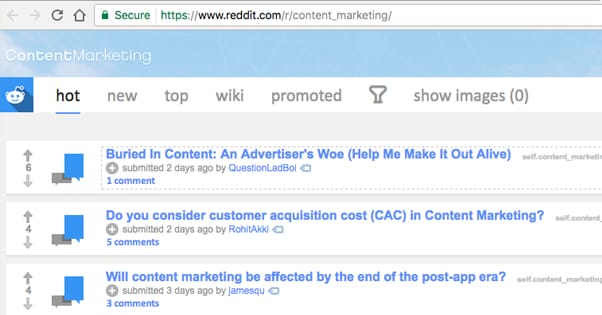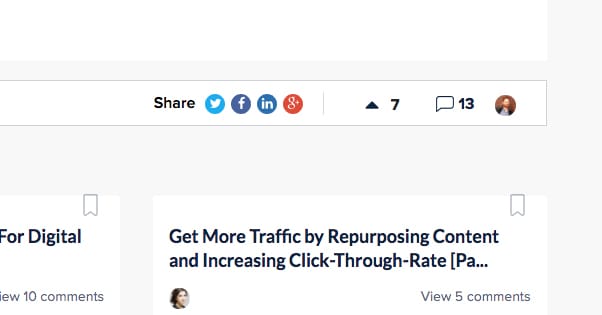How to Promote Your Blog Post in Groups and Aggregators
Published by Kenny Novak • Content Marketing • Posted February 24, 2017 ContentPowered.com
ContentPowered.com
I’m going to divide this post up into two main sections; one about group outreach and one about blog aggregators. Both are excellent for blog post promotion, if you use them properly. Both have the potential to backfire. And both require their own strategies to use effectively. Let’s get started!
Promoting Blog Posts in Groups
First up is groups. Groups, as a term, can apply to private or semi-public subsections of a broader site. Primarily, we marketers think of groups as the generic term for Facebook Groups, LinkedIn Groups, and groups on other sites like Triberr or even Twitter Lists. I’ve also seen some people treat Reddit subs as groups, though not always. In any case, you can follow the same basic process for all of them.
Step 1: Find good groups. This means you’re going to have to do your research. Search Facebook for keywords relating to your blog niche. When you run a search for a keyword, one of the options along the top bar is “groups.” Click that and you’ll see various groups relating to your keyword. Be warned, though; Facebook’s search is pretty bad. “Marketing” as a keyword brings up a lot of flea markets, for example. You’ll need to do some serious filtering. You can do the same with LinkedIn and any other site that has groups. LinkedIn has a cap on the number of groups you can join, which will be relevant if you’re trying to use as many as possible.
Groups on Facebook will show you the number of members in the group and how many new members have joined recently. You’re looking for groups that have high numbers for both, though an excessively high number of new members might mean that you won’t have room to distinguish yourself right away.
If you can visit the group without joining – that is, if their posts are visible to non-members – do so. Take a look at what kind of engagement the posts get, and what kinds of content are being posted. If it looks like it’s nothing but marketers trying to promote their blogs and no one engaging, it’s probably a bad target.
Step 2: Join your target groups. I don’t recommend joining an excessive number, at least not right away, simply because it can be hard to keep up with them. You don’t want to flood your feed and drown out value from other sources. Pick a handful of top-tier prospects to join and keep a list of other options later.
There’s no real tips for joining groups other than make sure you read the rules and, if they require any sort of introduction or engagement levels to remain, try to stay inside the bounds of what is acceptable. Also, if they have specific rules against advertising your own site, exercise caution. Some groups will allow it if it has enough value behind it, but others have zero tolerance.
Step 3: Participate in your target groups as a regular user. You aren’t just jumping in, dropping a link, and taking off. Your goal is to spend some time helping out the group whenever possible. Share links that are posted in the group. Offer advice to people who are asking questions. Link to resources outside of your own blog. You’re essentially trying to make yourself valued as a member of the community, rather than just some guy coming in to advertise. People will give you a lot more leeway when you do advertise if you’ve consistently provided value to your group members.
Step 4: Find relevant opportunities to share posts that benefit the group. Once you’ve been a member for a while, you’ll have probably been able to identify the kinds of topics that are usually discussed, the kinds of problems that come up, and the kinds of content people like. This means you can write a post that is likely to jive with them, or a post that will solve one of their common problems, or a post that anticipates a problem they have. Publish that kind of post – or find one you’ve written in the past – and link to it in the group. Make sure you give some context, with a post in the group about how you know the topic has come up and how you’ve done some research into it, and approach it from whatever angle you prefer. Are you doing it to help them, are you linking it because you’ve seen it come up before, or what?
Step 5: Monitor your results and leave groups that don’t benefit you. Every post you link should be run through a special set of UTM parameters so you can track the traffic coming from the group explicitly. What you’re looking for is an engagement rate and a view rate higher than when you share the post normally via social media. Conversion rates are good too. You want this post to perform well.
If the post performs well, good! You’ve found a good group and established yourself in a position of value. Keep it up, sharing a new post every month or so. If the post performs poorly, you should consider why that might be. Either it didn’t attract attention from the group audience, or they didn’t like it for one reason or another. In either case, I recommend giving it one more try. If a second post performs well, you know you just need to be more specific about what you’re sharing. If the second post performs poorly as well, it’s time to leave the group and pick up another one from your list to try again.
Eventually, you will build up a stable of groups you can reliably post content to and get extra traffic, value, and conversions. This is what you want. It will take some time and you’ll have to filter through groups to find the ones that really work, but it’s a winning strategy once you get it going.
Promoting Blog Posts via Aggregators
Aggregators are a little different than groups. In a sense they’re like groups, just based on their own websites. An aggregator is a site that doesn’t publish content of its own; rather, it has a daily feed of posts from other sites, ranked generally by the traffic and sometimes likes the posts get.
Aggregators run a variety of different styles. Some of them are simply merit-based. Reddit actually falls into this category; each day the feeds change somewhat, and the best content floats to the top as determined by upvotes. Some of them have special sponsored slots, occupied by people who pay for the exposure regardless of the merits of their content.
There are some risks to using blog aggregators. For one thing, there are a million of them out there, and a lot of them aren’t very good. They’re flooded with spam, the top spots are always occupied by a few blogs that repeatedly pay to have their spam float on top, and they have little or no SEO value. Other aggregators end up sending you no traffic simply because they don’t really have readers, just people who visit to submit their own content. Still others require payment for even basic submission, and you’re almost always going to be paying more than the exposure is worth.
The process for using blog aggregators is much the same as using groups, though.
Step 1: Find good aggregators. You’re looking for aggregators that are indexed in Google, that have a good reputation, and that cover your topic. Niche aggregators are generally better than broad all-industry aggregators because there’s less competition and more focus, so less spam. Even with aggregators that have a good reputation, you need to test and make sure they actually send you value. Here are some suggestions, but I recommend looking for aggregators in your niche as well.
- Alltop – One of the broadest and best aggregators around, it has a lot of competition and not a lot of space for new blogs. If you can get featured it will be a huge boost, however.
- BlogEngage – An aggregator primarily focusing on tech, blogging, education, health, and entertainment niches.
- BizSugar – An aggregator focusing on small business tips and news, including a range of blogging, finance, management, and even legal topics.
Step 2: Submit your content to the aggregators. Many aggregators need nothing more than a link once you have registered, so this part is easy. Just follow their submission guidelines, if they have any. I might recommend studying the site for a few weeks to see what sort of content floats to the top, and producing content more likely to “go viral” on the aggregator. That’s up to you, though. Aggregators tend to have a low enough return on investment that it’s not really worth writing posts specifically for their generally small audiences.
Step 3: Monitor for what value they offer, weeding out bad aggregators. You’re going to have to be very discerning here, because aggregators generally don’t have too much traffic. As you might expect, a lot of the people visiting these sites are there to submit, not to browse. It’s the same problem with a lot of different traffic sharing programs. You should make sure to, again, submit URLs with UTM parameters that you can track specifically, so you know exactly how much traffic each aggregator is sending and how well you’re performing.
Aggregators don’t have a huge investment to submit, so you can be a little more forgiving. If the aggregator even gets you a single conversion or a marginal chunk of traffic, that’s still more than you had before. It’s worth the few seconds it takes to submit the content with each post you publish. It’s only when the viewers are obviously fake, when the link gets no traffic at all, or when you actually take a hit to your SEO that you want to weed out that aggregator.
Step 4: Promote the aggregator occasionally. You can link to the aggregator in your mailing list, share it on your social media, or link to it in a blog post you write about promoting on aggregators. You know, the usual. The idea is to get a bit of cyclical value going on; the more traffic the aggregator gets, the better off your blog will perform, right? Of course, it’s going to be minimal, so I wouldn’t likely mention them more than once a month.
Finally, you can choose to pay for promotion on the aggregators if you wish. I highly recommend only doing this on an extremely limited basis, and only if you’re sure it’s a site that’s going to send you real value. If they’re likely at all to send fake traffic, or if they’re not sending you much of anything, it doesn’t make sense to pay for submission or promotion. You can take those dollars and spend them on Google or Facebook ads instead, for much greater effect.
So there you have it; the easy way to promote your blog through both social groups and through blog aggregators. In both cases you need to have strong content, you need to submit it to the right sources, and you need to watch for the results to see how they do. Optimize the amount of effort you put in compared to the value you get out of it. If you find yourself slipping in value or spending too much time, adjust your strategy.
If you have favorite groups you’re willing to share, or aggregators you’ve had a lot of success with, feel free to submit them in the comments! I can’t guarantee I’ll use them or link to them, but I’d like to see what my audience is using.










Thanks for this post blog pros. I am starting my Reddit strategy today. Reddit at times feels like a hit or miss however. But I will definitely try and add it to my marketing strategy